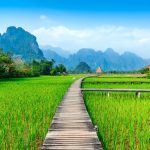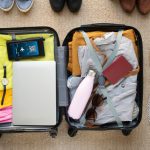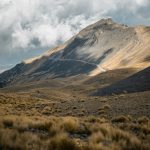Table of Contents
I’ve guided over 50 trekkers to Everest Base Camp, and I can spot an unprepared hiker from their pack alone. After watching countless dreams shatter due to poor gear choices, I’m sharing every hard-learned lesson about what you need to reach 5,364 meters. This isn’t your typical packing list for trekking- it’s a survival guide tested in one of the world’s most unforgiving environments.
Core Clothing – Your First Line of Defense
Let’s start with the absolute truth about clothing at altitude: layering isn’t just important, it’s essential for survival. Your base layer needs to be merino wool – forget everything you know about cotton because it’s worse than useless when wet. Pack two complete sets of long-sleeve tops and bottoms in merino wool. One set is for wearing, one for washing, and yes, you’ll be grateful for this rotation system by day three.
For your mid-layers, invest in both a lightweight and heavyweight fleece. The temperature fluctuations are extreme, and you’ll find yourself constantly adjusting layers throughout each day. A good quality insulated vest adds versatility without bulk – worth its weight in gold during those tricky temperature transitions at higher altitudes.
Your outer layer system needs serious consideration. A down jacket with a minimum 700-fill power is non-negotiable. Make sure it packs small because you’ll carry it everywhere, even on warmer days. Your waterproof shell jacket and pants need to be genuinely waterproof, not just water-resistant. The difference becomes painfully clear during an unexpected mountain storm.
The Truth About Footwear
Your boots can make or break your entire expedition. I’ve watched trekkers turn back at Namche Bazaar because of poor footwear choices. You need waterproof, insulated hiking boots with solid ankle support, and here’s the crucial part – they must be broken in for at least two months before the trek. One client ignored this advice and attempted the trek in new boots. Three days later, they were back in Kathmandu nursing savage blisters.
Don’t forget about evening footwear. After a long day of trekking, your feet will be cold, wet, and miserable. A pair of down booties for teahouses becomes a mental health essential. They’re light, pack small, and provide incredible comfort when you need it most.
Sleep System – Your Recovery Secret
The importance of good sleep at altitude cannot be overstated. Teahouses provide basic beds, but their blankets aren’t enough when temperatures plummet below freezing. Your sleeping bag needs to be rated to at least -10°C (14°F). I brought a -5°C bag on my first trek and spent every night shivering. A silk sleeping bag liner adds warmth and keeps your sleeping bag cleaner. An inflatable pillow might seem like a luxury, but it transforms those rock-hard teahouse pillows into something usable.
Technical Gear That Matters
The altitude changes everything about how your gear performs. Your electronics need special consideration because cold kills batteries faster than you’d believe. A power bank with a minimum 20,000mAh capacity is essential. Carry extra camera batteries and keep them close to your body to maintain their charge. A headlamp with spare batteries isn’t optional – power cuts are common, and you’ll often start trekking before sunrise.
Navigation requires redundancy. While most trails are well-marked, mountain weather can reduce visibility to zero in minutes. Download offline maps before you leave Kathmandu, carry a physical map, and know how to use both. A basic compass and the knowledge to use it could save your life in a whiteout.
The Medical Kit That Saves Lives
Altitude sickness doesn’t care about your Instagram photos or how fit you are. Diamox (altitude sickness medication) needs to be arranged before you leave home – get it prescribed and bring both the medication and the prescription paperwork. A pulse oximeter might seem excessive, but it’s your early warning system for altitude problems. That $30 investment could save your entire trek.
Your first aid kit needs careful consideration. Beyond the basics of bandages and blister treatment, you need altitude headache medication, throat lozenges (the air is desperately dry), and electrolyte packets. The notorious Khumbu cough is real and brutal – pack cough medicine and plenty of throat lozenges. Include broad-spectrum antibiotics (prescribed before travel), anti-diarrhea medication, and any personal prescriptions with their documentation.
Personal Care at Altitude
Staying clean becomes a luxury above 4,000 meters. Showers are rare and expensive, so wet wipes become your best friend. Pack biodegradable soap, a quick-dry towel, and plenty of hand sanitizer. The extremely dry air will ravage your skin – bring heavy-duty moisturizer and lip balm with high SPF. Sunscreen needs a minimum SPF of 50 – the sun’s intensity at altitude is fierce.
Backpack Strategy
Your life will exist in two bags: a daypack (30-35L) that you carry, and a duffel (60-70L) that goes with your porter. Your daypack carries only daily essentials: water, snacks, rain gear, a camera, first aid basics, an extra layer, sunscreen, and cash for tea stops. Everything else goes in the duffel, organized in waterproof dry bags.
The Often-Forgotten Essentials
Some items rarely make packing lists but prove invaluable on the trail. A portable clothesline and safety pins make drying clothes possible in teahouse rooms. Rubber sandals for shared bathrooms protect your feet and sanity. Ziplock bags protect electronics and documents from moisture. A deck of cards provides entertainment during long evening hours when power is out and you’re trying to acclimatize.
Weight – The Final Truth
Every extra gram feels like a kilogram at altitude. I started my first trek with “just in case” items that I ended up paying a porter extra to carry. Be ruthless with your packing. If you’re questioning whether you need something, you probably don’t. The only exception is medical supplies – better to have and not need than need and not have.
Strategic Packing Order
The order you pack matters almost as much as what you pack. Start with your sleeping bag at the bottom of your duffel – you won’t need it until evening. Layer clothing in order of when you’ll need it, keeping your warmest layers easily accessible. Pack your first aid kit and toiletries near the top of your duffel for quick access. In your daypack, organize items by priority: water and snacks inside pockets, emergency gear in top compartments, and extra layers in the main compartment. This systematic approach saves precious time and energy when you’re exhausted at altitude.
Journey to Base Camp
The mountain doesn’t care about your comfort, only your preparation. Pack smart, pack light, and remember – your success starts with what’s in your bag. Ready to stand at the foot of the world’s highest mountain?

I’m Garrett, a seasoned photojournalist with a passion for uncovering the world’s hidden treasures. My journey is fueled by a deep curiosity for diverse cultures and breathtaking landscapes. When I’m not behind the lens capturing the world’s wonders, you can find me exploring underwater realms or sharing my passion for discovery with my two adventurous children.




